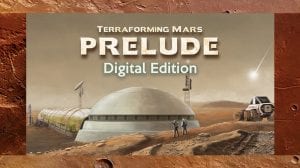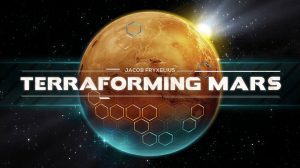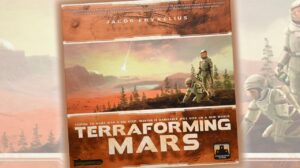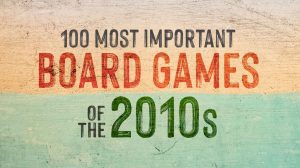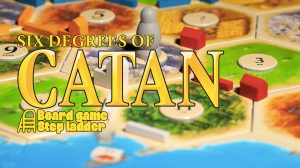In the 2400s, mankind begins to terraform the planet Mars. Giant corporations, sponsored by the World Government on Earth, initiate huge projects to raise the temperature, the oxygen level, and the ocean coverage until the environment is habitable. In Terraforming Mars, you play one of those corporations and work together in the terraforming process, but compete for getting victory points that are awarded not only for your contribution to the terraforming, but also for advancing human infrastructure throughout the solar system, and doing other commendable things.
The players acquire unique project cards (from over two hundred different ones) by buying them to their hand. The projects (cards) can represent anything from introducing plant life or animals, hurling asteroids at the surface, building cities, to mining the moons of Jupiter and establishing greenhouse gas industries to heat up the atmosphere. The cards can give you immediate bonuses, as well as increasing your production of different resources. Many cards also have requirements and they become playable when the temperature, oxygen, or ocean coverage increases enough. Buying cards is costly, so there is a balance between buying cards (3 megacredits per card) and actually playing them (which can cost anything between 0 to 41 megacredits, depending on the project). Standard Projects are always available to complement your cards.
Your basic income, as well as your basic score, is based on your Terraform Rating (starting at 20), which increases every time you raise one of the three global parameters. However, your income is complemented with your production, and you also get VPs from many other sources.
Each player keeps track of their production and resources on their player boards, and the game uses six types of resources: MegaCredits, Steel, Titanium, Plants, Energy, and Heat. On the game board, you compete for the best places for your city tiles, ocean tiles, and greenery tiles. You also compete for different Milestones and Awards worth many VPs. Each round is called a generation (guess why) and consists of the following phases:
1) Player order shifts clockwise.
2) Research phase: All players buy cards from four privately drawn.
3) Action phase: Players take turns doing 1-2 actions from these options: Playing a card, claiming a Milestone, funding an Award, using a Standard project, converting plant into greenery tiles (and raising oxygen), converting heat into a temperature raise, and using the action of a card in play. The turn continues around the table (sometimes several laps) until all players have passed.
4) Production phase: Players get resources according to their terraform rating and production parameters.
When the three global parameters (temperature, oxygen, ocean) have all reached their goal, the terraforming is complete, and the game ends after that generation. Count your Terraform Rating and other VPs to determine the winning corporation!
Buy Terraforming Mars on Amazon
The first expansion for the digital version of Terraforming Mars is finally available! Is Prelude worthy of your consideration? Read our review to find out!
Read our review to find out if the digital version of Terraforming Mars really captures all of the board, bits, and cards into an app worthy of your attention.
Mars is constantly on the mind of pop culture. Read our Terraforming Mars review to see how you can take the Mars habitation narrative into your own hands as...
Justin kicks off a new series with visits to some of the most prominent business players in tabletop. In our first piece, find out what it looks like to spend...
The Meeple Mountain team looks back on another great year of gaming. What games were our favorite in 2024? Read on to find out!
Maryland has a small convention named Congress of Gamers. It's a good convention, so it seemed a good idea to learn something from the man behind the con. Join...
In First Take Fridays we offer hot takes on games that are new to us. This week we have The Last Kingdom, Terraforming Mars, Sugar Heist, Coffee Rush, Splito.
It’s OK to quit a game when the outcome is far, far out of reach. Join Justin to find out why, and tips for how to make your friends see the light.
Did you know there are more trees on Earth than there are stars in the Milky Way? Or that there are over 1500 board games about Outer Space? Now you do!
Join us as we explore how board games can be used for science communication and what the game Evolution: Climate can teach us about its subject matter.
3D printers are an affordable, fun way of creating all sorts of useful things. See how I’ve used 3D printing to improve some of my favorite games in this Top 6...
Ten years is a long time in board gaming! Join us as we look back on the smart, influential, weird and crazy things that emerged from the last decade of games.
In today's step ladder, we celebrate Catan and explore the way it has influenced many of the games that have followed in its wake.
The Meeple Mountain 2019 Gift Guide is the perfect way to find something special for that for that someone special in your life. Let us guide you to the best...
Check out our Top 6 list of games that would be better with just a little TLC. The games on this list are fantastic on their own merit, they could gain legions...
Whenever you get a group of board gamers together, there is always one question that is inevitably asked. A quick look through my social media feeds will have...
Have you ever had to try to describe a game in a single phrase? Here’s a satirical look at some honest game descriptions of our favorite (or least favorite)...
Dim the lights, raise the curtain, and take your buttery fingers off my games, because today we're talking about movies and the games they were meant for.
The Meeple Mountain 2017 Holiday Gift Guide is the perfect way to find a great gift for that special gamer in your life. Let us lead you to the best gaming...
The Meeple Mountain team was hard at work during Gen Con 2017, getting the scoop on the latest board game news, upcoming titles, and current smash hits. Did we...



